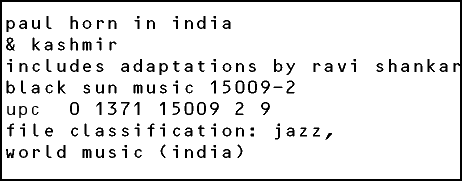

the project
When
Ravi Shankar visited Los Angeles in 1965, it was
Paul Horn who introduced the Indian musician to some of the more prominent
L.A. musicians. Shankar chose Horn to perform on flute for his Portrait
of a Genius album. Under the sitar player's concentrated tutelage, Horn
quickly mastered the forms and demands of Indian classical music. When
the flutist traveled to India to study transcendental meditation in
1966, he took advantage of the opportunity to make his own recordings
with some of the country's most promising musicians.
Black Sun's seventy-seven minute digitally remastered compilation,
Paul Horn In India & Kashmir, brings together the two albums
first released in 1968, In India and Paul
Horn In Kashmir. This CD offers some of Horn's most profound,
cross–cultural expressions, as well as one of the most accessible
presentations of classical Indian music to be found anywhere. The
first seven cuts feature students of Ravi Shankar playing with Horn.
Although he does not appear on the recording himself, the sitar master
adapted three classical răga melodies especially for the session.
Horn's languid, yet technically adept, flute improvisations meld perfectly
with the artful performances of native vina, sitar,
tabla, and tambura players. The remaining six cuts
were recorded in Kashmir with a group of musicians attending to the
Maharishi Mahesh Yogi, the renowned meditation guru
with whom Horn was studying. The resulting collaborations between
the flutist and his Indian hosts explore a wide variety of moods and
tempos: melancholy evening răgas, light classical pieces, popular
religious songs, and late night răgas in praise of beauty and
nature.
the artist
A classically trained flutist, Paul Horn played jazz with
Chico
Hamilton, served as a top studio musician in Los Angeles, and
recorded with his own quintet in the early 1960s. During that time,
he won two Grammy Awards for his
Jazz Suite On The Mass Texts.
Increasing dissatisfaction with the Hollywood lifestyle led Horn to
India on his search for alternatives, where he studied meditation and
began to explore other ways of playing his instrument. The success of
his intuitive and contemplative improvisations on
Inside the Taj
Mahal (
11062) proved that audiences were
ready for a new approach, and opened the door to a series of recordings
inside acoustic and architectural wonders around the world, including
Inside the Great Pyramid (
12060)
and
Inside the Cathedral (
11075). Both
Horn's cross–cultural collaborations, and his highly refined works
for more conventional Western ensembles have garnered much critical
acclaim.


